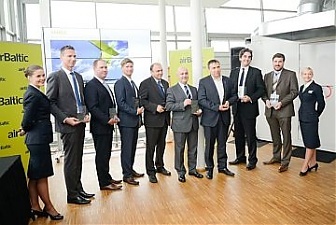Airport, Ecology, Energy, EU – Baltic States, Good for Business, Latvia, Transport
International Internet Magazine. Baltic States news & analytics
Thursday, 25.12.2025, 08:45
airBaltic: AMBER green flying project completed
 Print version
Print version |
|---|
Announced in 2013, the AMBER enabled the operation of Europe’s first green flights for turboprop aircraft. AMBER has laid a solid foundation to establish new arrival procedures for Riga Airport that will shorten the distances flown, improve flight trajectories to avoid residential areas and reduce people’s exposure to noise, as well as cut fuel consumption and emissions. The project introduced satellite-based approach procedures at Riga Airport for airBaltic’s state-of-the art Bombardier Q400 Next Gen turboprop aircraft and thus helped to practice greener flying.
The main objective of the AMBER (Arrival Modernization for Better Efficiency in Riga) project was to introduce new arrival procedures at Riga International Airport, to reduce CO2 emissions and noise levels at the airport and close vicinity, especially the touristic Jurmala area located on the coastline of Latvia, north west of the airport. The new trajectory is up to 30 nautical miles shorter towards runway than what was being flown previously, and enables reducing CO2 emissions by up to 300 kg on every Q400 flight. When rolled out to its full scale, the green flying will reduce CO2 emissions by 5 000 000 kilograms annually for airBaltic.
“The new green procedures that have been established and flown with our Bombardier Q400 Next Gen turboprops will be available to any airline flying to Riga with the relevant aircraft equipment. The procedures will also be suitable for our brand new Bombardier CSeries jets, which will be introduced into service in 2015, and will provide further benefits for operations out of Riga, on top of their unmatched fuel efficiency”, states Capt. Pauls Calitis, Vice President Flight Operations of airBaltic.
The AMBER project is implemented by airBaltic in partnership with Airbus ProSky subsidiary specialized in modern flight operations solutions and Latvia’s Air Navigation Service Provider LGS and sponsored by SESAR, the air traffic management research programme of the Singe European Sky. With this project, SESAR will be able to demonstrate that the entire commercial aviation community, including regional aircraft, can change and reduce its impact on the environment.
airBaltic serves 60 destinations from its home base in Riga, Latvia. airBaltic offers convenient connections via North Hub Riga to its network spanning Europe, Scandinavia, Russia, CIS and the Middle East.
The AMBER project is one the SESAR-sponsored projects introducing innovative initiatives to demonstrate the sustainability of the aviation industry, and achieving environmental benefits with improved and tailored ATM procedures.
The main objective of the AMBER (Arrival Modernization for Better Efficiency in Riga) project was to introduce PBN arrival procedures at Riga International Airport, to reduce CO2 emissions and noise levels at the airport and close vicinity, especially in the touristic Jurmala area located on the coastline of Latvia, north west of the airport. These objectives were achieved by demonstrating green flights using the Bombardier Q400, a first in Europe with a regional aircraft flying PBN procedures. The main routes flown by airBaltic’s Q400 fleet (such as Vilnius-Riga, Palanga-Riga or Warsaw-Riga) were used as a benchmark for comparison of the CO2 emissions. Introducing PBN for Riga arrivals enabled airBaltic to avoid flying over the touristic Jurmala area and, instead of flying a long radar vectored path over the Baltic Sea, the flights went directly to the runway by using the flexibility of a Radius-to-Fix (RF) leg and fully-guided procedures flown using the aircraft’s autopilot, thus reducing the flight crew’s workload in the approach phase of flight.
The AMBER project aimed to establish new trajectories up to 30NM shorter than what was being flown previously. The PBN approaches also allowed for Continuous Descent Operations (CDO) from the cruise to the final approach, thus further optimizing the efficiency of the operation compared to today’s procedures.
These procedures were also designed to be used by common jetliners such as Airbus and Boeing aircraft to ensure that, in the long run, any operator flying to Riga with the required aircraft equipment, is able to benefit from these enhanced arrivals. The procedures will also be suitable for the brand new Bombardier C-Series aircraft that Air Baltic will operate from 2015.
The AMBER project’s success stems from partnership. Having on board the Air Navigation Service Provider, the Airline, the ATC, the Aviation Regulator and the airport authority is the best approach to really deliver performance improvement to the Air traffic Management.
Performance-Based approach is a key element to support the decongestion of the busy terminal areas and increase the Air Traffic Management fuel efficiency in Europe.
Pilots and Air Traffic Controllers were specifically trained on simulators for the new procedures. A target of 100 flight trials was exceeded and 124 flights were carried out, and the CO2 savings (up to 30% for the approach phase) were analysed for publishing as a baseline for PBN & CDO implementation for turboprop operations.








 «The Baltic Course» Is Sold and Stays in Business!
«The Baltic Course» Is Sold and Stays in Business!

